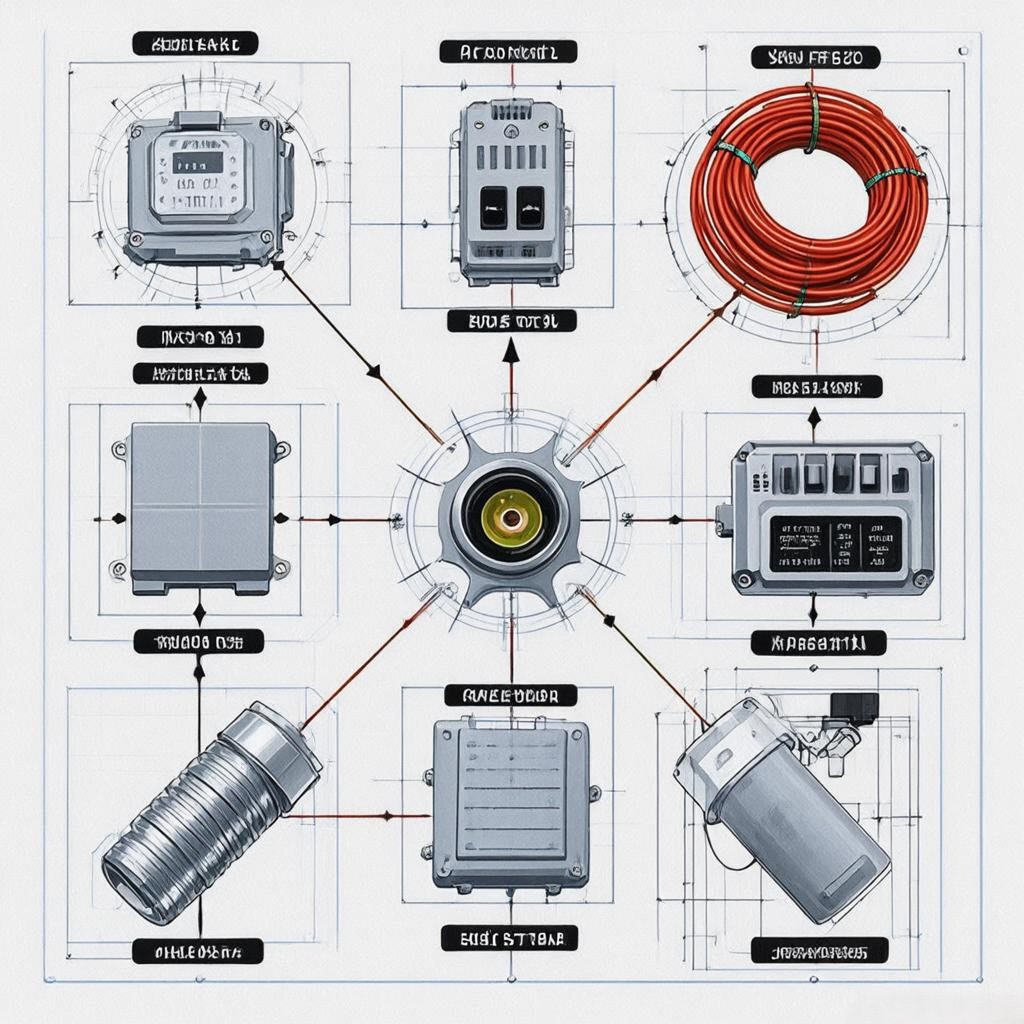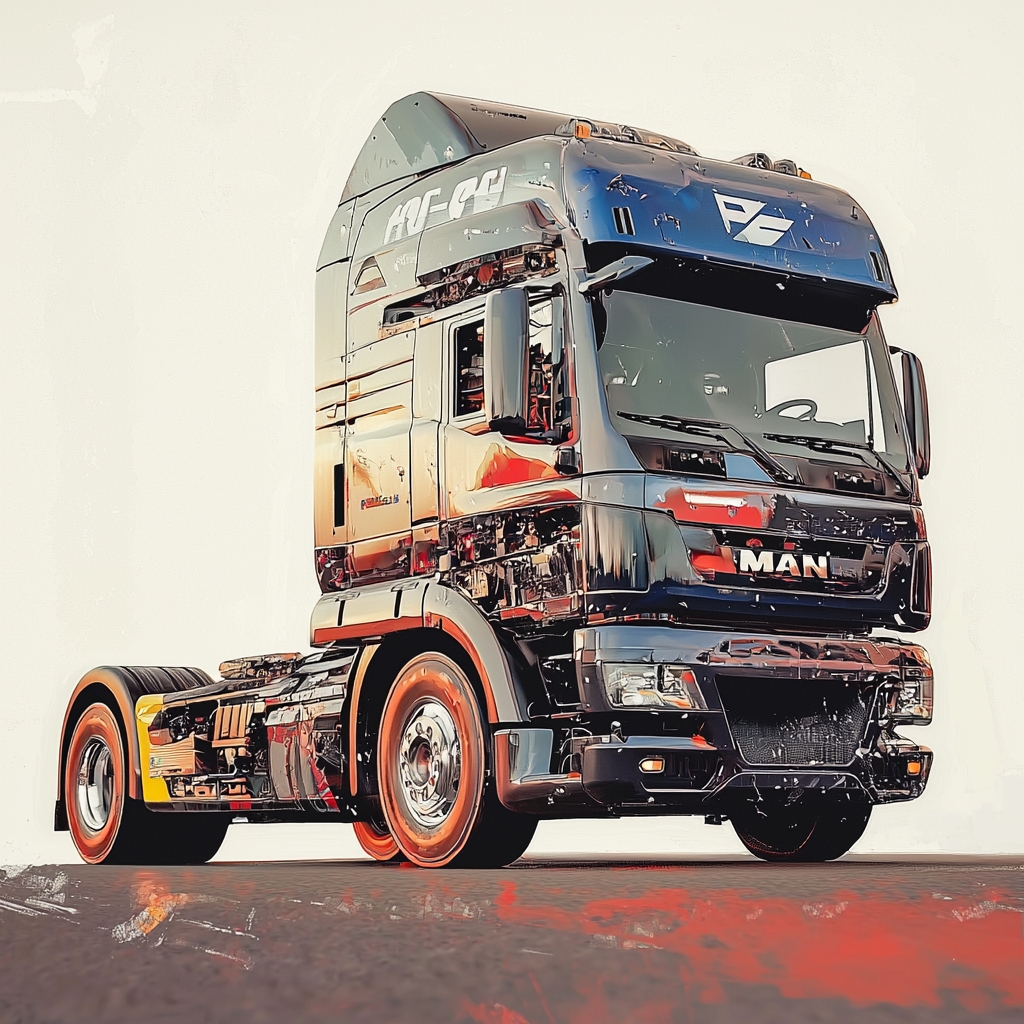Heavy Commercial Vehicle (HCV) suspension systems represent the critical interface between a vehicle’s chassis and its payload, combining engineering precision with robust materials to manage immense loads while maintaining ride quality, stability, and safety. These systems must simultaneously support static and dynamic loads exceeding 40 tons, adapt to varying road conditions, and ensure precise handling characteristics for multi-axle configurations. This comprehensive technical analysis explores the complete ecosystem of HCV suspension systems, their functional components, advanced material innovations, and the evolving landscape of suspension technologies tailored for heavy-duty applications.




1. Fundamental Role of Suspension Systems in HCVs
HCV suspension systems serve as the structural backbone that connects the vehicle chassis to its axles, performing several mission-critical functions:
- Load distribution: Evenly spreading payload weight across axles (up to 40,000kg per axle group)
- Vibration isolation: Attenuating road-induced vibrations to protect cargo and vehicle components
- Stability control: Maintaining geometric alignment during cornering and braking
- Height adjustment: Enabling load-leveling capabilities for varying payloads
Technical specifications:
- Maximum load capacity: 20-40 tons per axle
- Dynamic deflection: 50-150mm under full load
- Operating temperature range: -40°C to +120°C
Industry significance: Modern HCV suspensions directly influence 30% of vehicle maintenance costs and 50% of tire wear patterns, while enabling payload capacities that are 3-5x higher than passenger vehicle equivalents.
2. Core Suspension Components and Functional Architecture
2.1 Primary Load-Bearing Components
Leaf Springs
- Multi-leaf configurations: 4-14 leaves per pack with graduated thickness
- Material: High-carbon spring steel (0.7-1.2% C content) with shot peening treatment
- End attachments: Eyebolt or shackle designs with rubber bushings
- Load capacity: 10-25 tons per spring pack
Air Springs (Alternative for Advanced Systems)
- Double-convoluted bellows: 500-2,000mm diameter with Kevlar reinforcement
- Operating pressure: 0.5-1.2 MPa (72-174 psi)
- Load capacity: 8-15 tons per air spring
- Height control: Electronic leveling valves (±2mm precision)
Performance metrics:
- Static stiffness: 20-80 N/mm for leaf springs
- Dynamic stiffness: 1.2-2.5x static stiffness under vibration
- Fatigue life: 1 million cycles at rated load
2.2 Shock Absorption and Motion Control
Shock Absorbers
- Hydraulic twin-tube design: 50-100mm bore with nitrogen gas pressurization
- Damping characteristics:
- Compression damping: 500-2,000 Ns/m
- Rebound damping: 800-3,000 Ns/m
- Heat dissipation: 1,000-2,000W peak cooling capacity
Anti-Roll Bars (Stabilizers)
- Diameter: 25-40mm solid steel bars
- Torsional stiffness: 5,000-15,000 Nm/rad
- Mounting configuration: Center-mounted with rubber bushings
Dynamic performance:
- Roll gradient: 0.2-0.5°/g lateral acceleration
- Pitch control: 30-50% reduction in braking dive
- Articulation angle: 15-25° for off-road applications
2.3 Axle Positioning and Geometry Control
Panhard Rods
- Material: Forged alloy steel (34CrMo4) with chrome plating
- Diameter: 50-80mm with spherical bearings
- Mounting angles: 10-20° from horizontal plane
Watt’s Linkage Systems
- Precision alignment: ±0.1mm manufacturing tolerances
- Load distribution: Equalizes lateral forces between axles
- Material: High-strength aluminum alloys (7075-T6)
King Pins and Bushings
- Bearing types: Tapered roller or spherical roller bearings
- Load capacity: 5-15 tons per bearing
- Lubrication: Grease-filled with temperature-resistant additives
3. Advanced Material Formulations and Engineering Innovations
3.1 Spring Material Advancements
High-Strength Steel Alloys
- 51CrV4 steel:
- Tensile strength: 1,200-1,400 MPa
- Fatigue limit: 500 MPa at 10^7 cycles
- Heat treatment: Quenching and tempering at 400-500°C
Composite Leaf Springs
- Glass fiber-reinforced polymers:
- Specific stiffness: 100 GPa/(g/cm³)
- Corrosion resistance: Immune to environmental degradation
- Weight reduction: 60-70% vs. steel equivalents
Surface Treatment Technologies
- Laser peening: Residual compressive stresses up to 1,000 MPa
- Plasma nitriding: Surface hardness 1,000-1,200 HV
- Zinc-aluminum diffusion coating: Cathodic protection for corrosion resistance
3.2 Shock Absorber Innovations
- Magnetorheological dampers:
- Adjustable damping force (200-3,000 Ns/m)
- Response time: <10ms for mode switching
- Integrated sensors for real-time control
- Gas-filled accumulators:
- Nitrogen precharge pressure: 0.5-1.5 MPa
- Volume compensation: ±15% for temperature variations
- Leak detection: Pressure sensors with 0.1bar resolution
3.3 Lightweight Structural Components
- Aluminum alloy crossmembers:
- 6082-T6 extrusions with 300MPa yield strength
- Weight reduction: 40% vs. steel designs
- Corrosion protection: Anodizing with sealant
- Composite bushings:
- Polyurethane with embedded PTFE liners
- Friction coefficient: 0.08-0.12
- Service life: 100,000km+
4. Dynamic Performance Characteristics and Testing
4.1 Load Distribution and Stability Analysis
Multi-body Dynamics (MBD) Simulation:
- Vehicle models: 15-20 degree-of-freedom systems
- Load cases:
- Static loading with 20-100% payload variations
- Dynamic maneuvers (sine sweep, double lane change)
- Emergency braking (0.3-0.5g deceleration)
Real-world testing protocols:
- Weigh-in-motion systems: 0.1% accuracy load measurement
- Deflection gauges: Strain-based displacement measurement
- Axle load distribution: ±2% target uniformity
4.2 Vibration and Comfort Metrics
Frequency response analysis:
- Primary ride frequencies: 1-3Hz for highway cruising
- Secondary ride characteristics: 8-15Hz for road texture filtering
- Noise transmission: <70dB(A) cabin noise at 80km/h
Testing methodologies:
- Road simulators: 4-post test rigs with programmable profiles
- Proving ground evaluations: Gravel, cobblestone, and washboard surfaces
- Passenger comfort assessment: Vibration dose value (VDV) measurements
4.3 Durability and Fatigue Testing
Accelerated life testing:
- Block cycle testing: 1,000,000 cycles equivalent to 10 years of service
- Extreme load conditions: 150% overload pulses
- Environmental simulation:
- Temperature cycling: -40°C to +80°C
- Salt spray exposure: 1,000 hours
- Dust ingestion tests: 500kg/m³ concentration
Failure mode analysis:
- Fracture mechanics: Crack initiation and propagation studies
- Finite element analysis (FEA): Stress concentration identification
- Non-destructive testing (NDT): Ultrasonic and magnetic particle inspection
5. System Integration and Vehicle Applications
5.1 Truck and Trailer Configurations
Tractor-trailer systems:
- 5th wheel coupling: 150-300mm vertical adjustment range
- Air suspension transfers: Load sharing between tractor and trailer axles
- Height control systems: Automatic leveling during loading/unloading
Dumper trucks and off-highway vehicles:
- Articulated suspensions: ±30° oscillation angles
- Hydropneumatic systems: Adjustable stiffness for varying payloads
- Locking differentials: Enhanced traction control
Performance metrics:
- Payload capacity: 20-40 tons per axle group
- Gradeability: 30-45% slopes with full payload
- Turning radius: 12-20m for urban applications
5.2 Specialized Heavy-Duty Applications
Mining and construction vehicles:
- Oscillation dampers: 50-100mm vertical travel absorption
- Extreme load frames: 100-200 ton capacity designs
- Corrosion protection: E-coating with ceramic topcoats
Military and defense applications:
- Run-flat suspensions: 50km operation at zero pressure
- Ballistic protection: Reinforced crossmembers (STANAG 4569 Level 3)
- Explosion-proof components: ATEX-certified designs
6. Design Challenges and Engineering Solutions
6.1 Balancing Load Capacity and Ride Comfort
Solution approaches:
- Adaptive damping systems: Real-time stiffness adjustment
- Multi-stage leaf springs: Progressive rate designs
- Air-spring hybrids: Combining steel and pneumatic elements
Performance targets:
- 20% improvement in ride comfort without sacrificing load capacity
- 30% reduction in vibration-induced component wear
- Consistent performance across -40°C to +50°C temperature ranges
6.2 Ensuring Long-Term Durability
Material innovations:
- Nanostructured steels: Improved fatigue resistance
- Self-healing polymers: Crack repair capabilities
- Advanced coatings: Diamond-like carbon for wear protection
Maintenance strategies:
- Predictive maintenance algorithms: Vibration-based condition monitoring
- Extended service intervals: 2-year/100,000km maintenance cycles
- Rapid replacement systems: Modular component designs
6.3 Meeting Regulatory and Safety Standards
Key compliance requirements:
- ECE R13 (Europe): Braking and suspension integration
- FMVSS 121 (USA): Air brake system compatibility
- GB 7258 (China): Commercial vehicle safety standards
Testing certifications:
- Salt spray resistance: ASTM B117 compliance
- Dynamic load testing: ISO 8608 standards
- Fatigue life verification: SAE J2380 protocols
7. Market Trends and Future Developments
7.1 Electrification and Alternative Powertrains
- Electric HCV suspensions:
- Battery pack integration with suspension crossmembers
- Regenerative damping systems for energy recovery
- High-voltage insulation requirements
- Hydrogen fuel cell vehicles:
- Lightweighting demands for increased payload
- Corrosion resistance for hydrogen environments
- Vibration isolation for fuel cell stacks
7.2 Advanced Materials and Manufacturing
- Carbon fiber reinforced polymers (CFRP):
- Potential weight savings: 50-70% vs. steel
- Specific stiffness: 200 GPa/(g/cm³)
- Manufacturing challenges: Cost and repairability
- Additive manufacturing:
- 3D-printed metal components with optimized topology
- Complex internal geometries for weight reduction
- Rapid prototyping for development cycles
- Smart materials:
- Shape-memory alloys for adaptive suspension components
- Piezoelectric energy harvesting from road vibrations
- Self-sensing materials for structural health monitoring
7.3 Autonomous and Connected Vehicle Integration
- Predictive suspension systems:
- Road condition anticipation algorithms
- Real-time stiffness adjustment based on traffic data
- V2X communication for coordinated braking
- Active suspension controls:
- Magnetic levitation for zero-deflection operation
- 48V electric actuators for rapid response
- Integration with ADAS for stability control
- Digital twin technology:
- Virtual suspension modeling for predictive maintenance
- Real-time performance monitoring
- Remote diagnostics and software updates
8. Case Studies: Real-World Implementations
Case Study 1: European Long-Haul Truck Suspension Upgrade
A major European truck manufacturer implemented adaptive air suspension systems in their latest models, achieving:
- 15% improvement in fuel efficiency through optimized ride height
- 25% reduction in tire wear
- 40% increase in cargo capacity without structural modifications
Case Study 2: Mining Truck Suspension Innovation
A global mining equipment supplier developed a specialized suspension system for 400-ton haul trucks, featuring:
- Oscillation damping of ±40mm vertical travel
- Load-sharing across 8 axles with electronic control
- Corrosion-resistant materials for extreme environments
Conclusion: The Foundation of Heavy-Duty Mobility
HCV suspension systems represent the critical interface between immense payloads and road surfaces, combining mechanical robustness with advanced engineering to enable safe and efficient heavy-duty transportation. As vehicles evolve toward electrification and autonomous operation, these systems must continue adapting to meet new challenges while maintaining their core function of load support and ride quality.
Key takeaways:
- Modern HCV suspensions integrate mechanical, hydraulic, and electronic components for comprehensive performance
- Advanced materials and manufacturing are pushing weight and durability boundaries
- Integration with electrification and autonomous systems requires new engineering solutions
- Sustainability and digitalization are shaping the next generation of suspension technologies
Final thought: In the world of heavy commercial vehicles, suspension systems are not just about absorbing shocks—they’re about enabling the reliable transportation of goods that drive global economies. The next generation of HCV suspensions will need to balance unprecedented payload capacities with the demands of electrification, autonomy, and environmental sustainability, making them one of the most critical areas of automotive innovation today.
Call to Action
🔧 Upgrading your HCV suspension system?
⚙️ Explore our advanced air suspension and adaptive damping solutions
📊 Request performance data comparing traditional vs. next-generation suspension systems
#HeavyCommercialVehicles, #SuspensionTechnology, #VehicleDynamics, #CommercialTransportation, #AdvancedMaterials, #AutomotiveEngineering, #Electrification, #SmartMobility, #FutureOfTransportation



